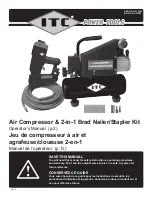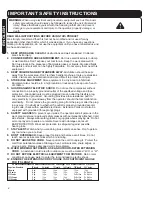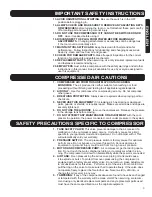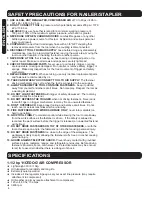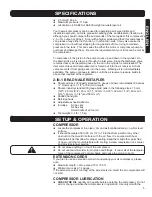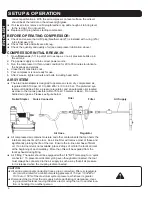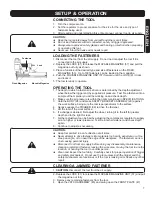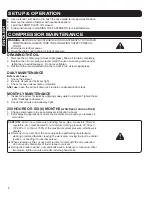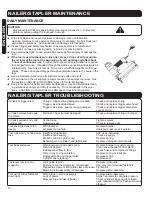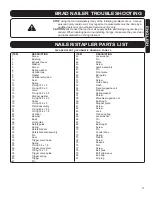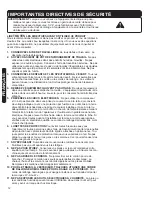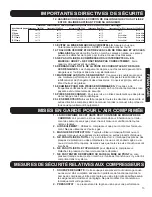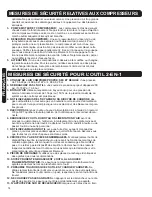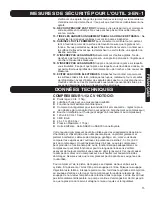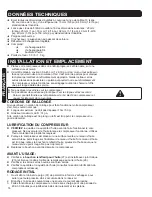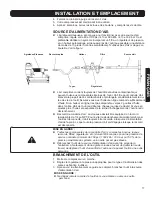
2
ENGLISH
FRANÇAIS
FRANÇAIS
ENGLISH
2
ENGLISH
FRANÇAIS
FRANÇAIS
ENGLISH
IMPORTANT SAFETY INSTRUCTIONS
WARNING:
When using electrical and pneumatic equipment such as this, basic
safety precautions should always be followed to reduce the risk of personal
injury. Please familiarize yourself with the following information to prevent
damage to your equipment and injury to the operator, property damage, or
death
READ
ALL
INSTRUCTIONS BEFORE USING THIS PRODUCT
We strongly recommend that this tool not be modified and /or used for any
application other than that for which it was designed. If you have any questions
relating to its application, do not use the equipment until you have consulted us and
we have advised you.
1. KEEP WORK AREA CLEAR
of obstructions and well ventilated. Cluttered
areas invite injury.
2. CONSIDER WORK AREA ENVIRONMENT.
Don’t use electrical tools in damp
or wet locations. Don’t expose your tool to rain. Keep the work area well lit.
Don’t use tools in the presence of flammable gases or liquids. Atomized fluids
like paints and solvents can be highly flammable. Do not spray them near this
equipment.
3. KEEP CHILDREN AND BYSTANDERS AWAY.
All children should be kept
away from the work area. Don’t let them handle machines, tools or extensions
cords. Visitors can be a distraction and are difficult to protect from injury.
4. STORE IDLE EQUIPMENT.
Store equipment in a dry area to inhibit rust.
Equipment also should be in a high location or locked up to keep out of reach
of children.
5. GUARD AGAINST ELECTRIC SHOCK.
Do not use the compressor without
connection to a properly grounded outlet of the specified voltage and fuse
protection. Grounded tools must be plugged into an outlet that itself is prop
-
erly installed and grounded. Grounding provides a low-resistance path to
carry electricity to ground away from the operator, should the tool malfunction
electrically. Do not remove the grounding prong from the plug or alter the plug
in any way. If in doubt as to whether the outlet is properly grounded accord
-
ing to code, check with a qualified electrician. Extension cords must also be
equipped with grounded (three prong) plugs.
6. SAFETY GLASSES
To prevent eye injuries, the operator and all persons in the
work area must wear approved safety glasses with permanently attached, rigid
side shields. Always wear safety glasses or goggles when spraying air. Do not
aim or spray air at people or animals. Severe skin damage can result.
EAR PROTECTION Wear ear protection to safeguard against possible
hearing loss.
7. STAY ALERT.
Watch what you are doing & use common sense. Don’t operate
any tool when you are tired.
8. DON’T OVERREACH.
Keep proper footing and balance at all times. Do not
reach over or across machines which are running.
9. DO NOT ABUSE THE CORD.
Never pull on the cord to unplug it. Protect the
cord from potential sources of damage: heat, oil & solvents, sharp edges, or
moving parts. Replace damaged cords immediately.
10. WHEN WORKING OUTDOORS, USE AN OUTDOOR-RATED EXTENSION
CORD.
An extension cord rated for outdoor use must be marked “W-A” or “W”.
11. DO NOT EXPOSE ELECTRICAL EQUIPMENT TO MOISTURE.
Rain or wet
conditions can cause water to enter the tool and lead to electric shock.
12. ENSURE THE EXTENSION CORD YOU USE IS OF SUFFICIENT GAUGE
FOR ITS LENGTH.
Recommended Minimum Wire Gauge for Extension Cords
Amps from Nameplate
25' length
50' length
75' length
100' length
150' length
200' length
0-5 amps
16 ga.
16 ga.
16 ga.
14 ga.
12 ga.
12 ga.
5.1-8 amps
16 ga.
16 ga.
14 ga.
12 ga.
10 ga.
Do Not Use
8.1-12 amps
14 ga.
14 ga.
12 ga.
10 ga.
Do Not Use
Do Not Use
12.1-15 amps
12 ga.
12 ga.
10 ga.
10 ga.
Do Not Use
Do Not Use
15.1-20 amps
10 ga.
10 ga.
10 ga.
Do Not Use
Do Not Use
Do Not Use

